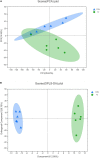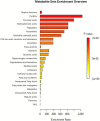Rumen fermentative metabolomic and blood insights into the effect of yeast culture supplement on growing bulls under heat stress conditions
- PMID: 36147855
- PMCID: PMC9486011
- DOI: 10.3389/fmicb.2022.947822
Rumen fermentative metabolomic and blood insights into the effect of yeast culture supplement on growing bulls under heat stress conditions
Abstract
This study was conducted to investigate the effects of yeast culture supplements on the physiological state and growth performance of growing bulls under heat stress conditions and the underlying mechanism. A total of 14 (6.0 ± 1.0 months old) growing bulls with similar body weight were randomly assigned into the control group (YC0g/d ) and yeast culture supplement group (YC40g/d ). YC0g/d contained three replicates, with two bulls in each replicate, which were fed a basal diet. Meanwhile, the YC40g/d treatment contained four replicates, with two bulls in each replicate, which were fed a basal diet supplemented with 40 g/day of yeast culture per cattle. Growth performance, nutrient digestibility, rumen fermentable metabolites, serum immunity, serum hormones, and serum antioxidant parameters were measured. Results showed that the average daily gain significantly increased (P < 0.05), while the feed-to-gain ratio significantly decreased (P < 0.01) after YC supplementation compared with the YC0g/d . The digestibility of neutral detergent fiber (P < 0.05) was higher in YC40g/d . There were no significant differences in ruminal pH, NH3-N, butyrate, or acetate/propionate (P > 0.05). Besides, the rumen MCP, acetate, propionate, and total VFA content remarkably increased with the supplement of YC (P < 0.05). Yeast culture supplementation increased the concentration of nicotinamide riboside, neuromedin B, peptides, and formyl-5-hydroxykynurenamine. The YC40g/d group had a significantly (P < 0.05) higher serum triiodothyronine level, serum glutathione peroxidase levels, and total antioxidant capacity while having a lower serum malondialdehyde level than the YC0g/d group. In conclusion, the addition of yeast culture in the diet improves the growth performance of growing bulls under heat stress by increasing nutrient digestibility, rumen fermentation function, antioxidant capacity, and rumen metabolites.
Keywords: antioxidant variables; growing bulls; growth performance; heat stress; metabolomics; yeast culture.
Copyright © 2022 Zhang, Liang, Xu, Zou, Zhang, Xue and Qu.
Conflict of interest statement
TZ was employed by ZheJiang Cofine Biotechnology Company Limited. FX was employed by Yangxin Yiliyuan Halal Meat Co., Ltd. The remaining authors declare that the research was conducted in the absence of any commercial or financial relationships that could be construed as a potential conflict of interest.
Figures



Similar articles
-
Effects of essential oils, yeast culture and malate on rumen fermentation, blood metabolites, growth performance and nutrient digestibility of Baluchi lambs fed high-concentrate diets.J Anim Physiol Anim Nutr (Berl). 2015 Apr;99(2):221-9. doi: 10.1111/jpn.12230. Epub 2014 Jul 24. J Anim Physiol Anim Nutr (Berl). 2015. PMID: 25060172 Clinical Trial.
-
Effects of yeast culture supplementation on lactation performance and rumen fermentation profile and microbial abundance in mid-lactation Holstein dairy cows.J Dairy Sci. 2021 Nov;104(11):11580-11592. doi: 10.3168/jds.2020-19996. Epub 2021 Aug 26. J Dairy Sci. 2021. PMID: 34454748
-
Effects of guanidinoacetic acid supplementation on growth performance, nutrient digestion, rumen fermentation and blood metabolites in Angus bulls.Animal. 2020 Dec;14(12):2535-2542. doi: 10.1017/S1751731120001603. Epub 2020 Jun 25. Animal. 2020. PMID: 32580813
-
Effect of supplemental yeast culture and dietary starch content on rumen fermentation and digestion in dairy cows.J Dairy Sci. 2018 Jan;101(1):201-221. doi: 10.3168/jds.2017-13241. Epub 2017 Nov 2. J Dairy Sci. 2018. PMID: 29103715 Clinical Trial.
-
Effects of soybean oil and dietary copper levels on nutrient digestion, ruminal fermentation, enzyme activity, microflora and microbial protein synthesis in dairy bulls.Arch Anim Nutr. 2020 Aug;74(4):257-270. doi: 10.1080/1745039X.2019.1679562. Epub 2019 Nov 13. Arch Anim Nutr. 2020. PMID: 31718315
Cited by
-
Yeast culture in weaned lamb feed: a proteomic journey into enhanced rumen health and growth.J Anim Sci Biotechnol. 2025 Aug 1;16(1):107. doi: 10.1186/s40104-025-01223-8. J Anim Sci Biotechnol. 2025. PMID: 40745344 Free PMC article.
-
Mechanism and application of yeast and its culture in regulating intestinal antioxidant defense in ruminants.Front Vet Sci. 2025 Aug 7;12:1657244. doi: 10.3389/fvets.2025.1657244. eCollection 2025. Front Vet Sci. 2025. PMID: 40852435 Free PMC article. Review.
-
Review of yeast culture concerning the interactions between gut microbiota and young ruminant animals.Front Vet Sci. 2024 Mar 1;11:1335765. doi: 10.3389/fvets.2024.1335765. eCollection 2024. Front Vet Sci. 2024. PMID: 38496306 Free PMC article. Review.
-
Effects of yeast culture (Saccharomyces cerevisiae) on growth performance, serum biochemistry, rumen fermentation and microbiota of intake-restricted multiparous Suffolk sheep.Front Microbiol. 2025 Aug 11;16:1601805. doi: 10.3389/fmicb.2025.1601805. eCollection 2025. Front Microbiol. 2025. PMID: 40862155 Free PMC article.
-
Effects of yeast culture on in vitro ruminal fermentation and microbial community of high concentrate diet in sheep.AMB Express. 2024 Apr 15;14(1):37. doi: 10.1186/s13568-024-01692-6. AMB Express. 2024. PMID: 38622373 Free PMC article.
References
-
- Ametaj B. N., Zebeli Q., Saleem F., Psychogios N., Lewis M. J. (2010). Metabolomics reveals unhealthy alterations in rumen metabolism with increased proportion of cereal grain in the diet of dairy cows. Metabolomics 6 583–594. 10.1007/s11306-010-0227-6 - DOI
-
- Armato L., Gianesella M., Morgante M., Fiore E., Ruzzo M., Giudice E., et al. (2016). Rumen volatile fatty acids × dietary supplementation with live yeast and yeast cell wall in feedlot beef cattle. Acta Agriculturae Scand. Sec. Animal Sci. 66 119–124. 10.1080/09064702.2016.1272628 - DOI
LinkOut - more resources
Full Text Sources
Miscellaneous

